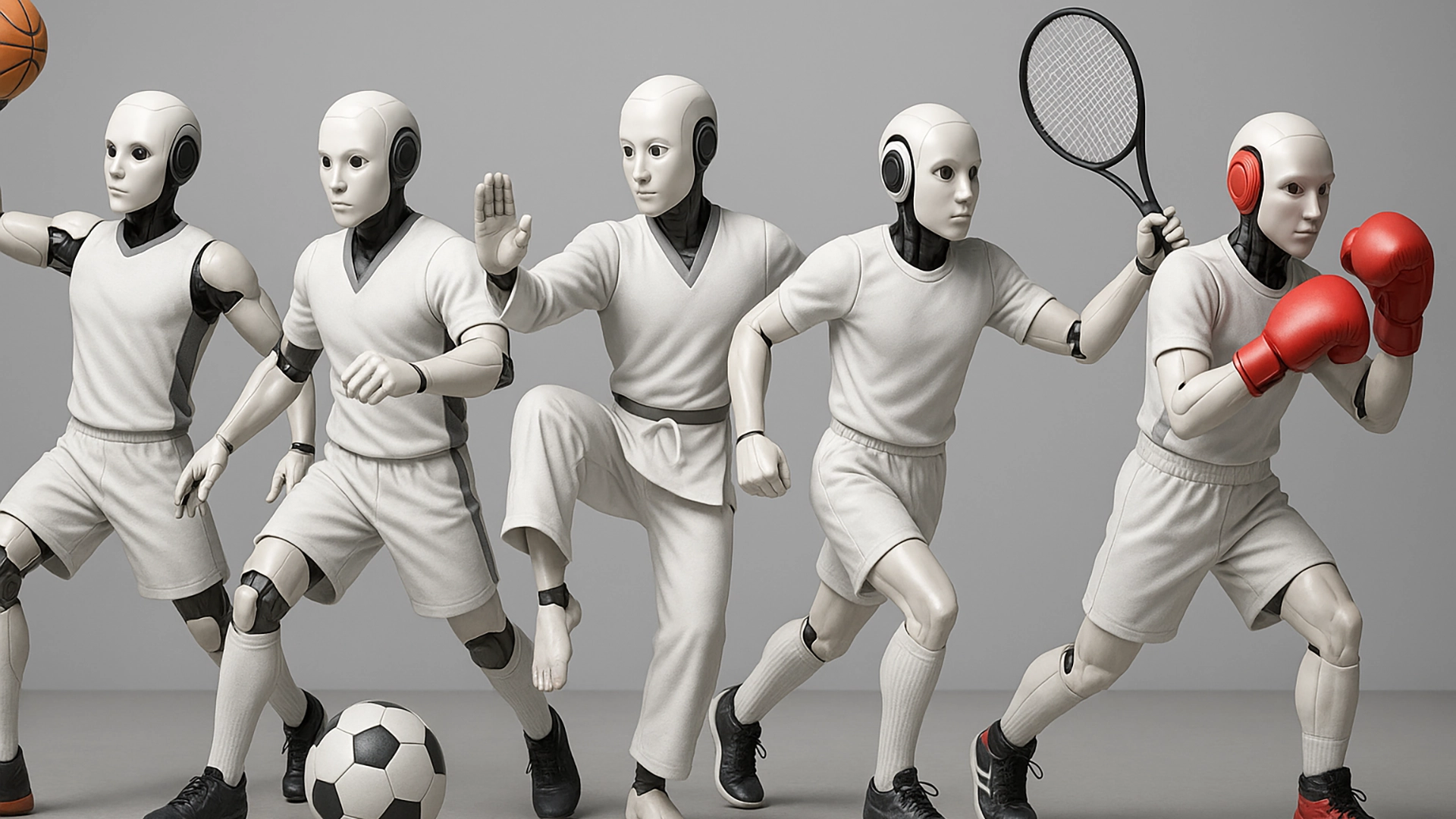
Image generated by ChatGPT
AI in Sports—Robots vs. Human Athletes
The tech industry and the sports industry are getting closer this year. Not only because AI experts are getting paid as much as famous soccer players, but also because now robots are performing better in the field and gaining fans. Could robots provide FIFA-level entertainment within the next couple of years?
Over the past year, we’ve seen a stronger connection between robotics and sports. The advancements in AI have enabled tech companies, universities, and research labs to develop machines capable of playing ping pong, running marathons, or even performing parkour.
Artificial General Intelligence (AGI) is many AI developers’ present focus. Creating a technology that can match human intelligence and movement—including athletic abilities—to be integrated with robots is the new goal. By 2030, we will probably see more robots perform as humans, and go from folding the laundry to human opponents in a tennis match.
We know that tech giants, such as Meta, are capable of paying the most talented AI researchers over $100 million—what Lionel Messi, LeBron James, Tiger Woods, or Conor McGregor could make in a year—to focus on making Mark Zuckerberg happy and build the advanced superintelligence that is supposed to blow our minds in a few years.
However, as we saw during the past sporting events hosted in China, the humanoid robots are not quite as smart, flexible, and agile as our talented humans. But will this change soon? Are athletes the next professionals getting replaced by AI technology? Why are tech companies developing machines that can move like runners or soccer players?
AI in Sports
In 2024, Google announced that DeepMind had developed a human-level competitive ping-pong robot. The researchers finally achieved a goal that many experts had been trying to reach since 1980: they created a powerful arm capable of playing amateur table tennis and beating Google workers.
Meet our AI-powered robot that’s ready to play table tennis. 🤖🏓
It’s the first agent to achieve amateur human level performance in this sport. Here’s how it works. 🧵 pic.twitter.com/AxwbRQwYiB
— Google DeepMind (@GoogleDeepMind) August 8, 2024
Other American companies, like Boston Dynamics, have been showing off their talented humanoid robots, such as Atlas, doing parkour since 2021. But it has been China the one taking the lead in robots in sports this year.
Recent Competitions in China
During the past few months, China has been hosting events to demonstrate local talent and advances in AI technology applied to sports, broadcast by China Central Television (CCTV). It has been paving the way for the World Robot Conference, set to take place in Beijing in August.
In April, humanoid robots ran next to human runners in the world’s first mixed half-marathon. While many machines were lost and couldn’t finish the race, the robot Ultra, developed by Tiangong Ultra from the Beijing Innovation Center of Human Robotics, completed the race in 2 hours and 40 minutes.
The next month, in May, the city of Hangzhou hosted the world’s first robot kickboxing competition. Robots developed by Unitree demonstrated impressive coordination, stability, and punching abilities.
And last month, in June, Beijing hosted the RoBoLeague 3‑on‑3 humanoid robot soccer tournament, featuring machines from the Chinese company Booster Robotics. The funny-looking robots kicked the ball across the field, fell multiple times, and provided great entertainment—better than the real human national team, according to people in the audience.
Although it was clear that the abilities of these amusing machines don’t come close to the natural skills of humans, the robots drew quite a few laughs from the audience and delivered high doses of excitement.
From Funny to Impressive… and Scary?
Little by little, like building an imaginary global Frankenstein masterpiece, AI researchers from all over the world have been making remarkable progress. Some are building arms that can move a racket across a table and learn from their mistakes. Robotics experts have created machines that can jump, run, and avoid obstacles. Meanwhile, other scientists develop the electronic “skin” that gives robots the “human touch.”
Even though not all the robotics companies and researchers have been able to successfully apply AI technology to build autonomous machines, the current developments give us the sense that, if more organizations collaborate and they keep doing what they are doing, we will get to something truly mind-blowing soon.
And certain companies, like the Chinese Unitree, are already making a big impression on people. Its latest Kungfu BOT recently showcased its Kung Fu abilities—filmed in a parking lot—gracefully moving its legs and arms in the air, correcting its steps for balance, all while keeping its ID badge around the neck.
Many users on YouTube shared their thoughts. “Although the kicks weren’t as fast as lightning, this is still a little bit frightening,” wrote one user in the comments. “Didn’t think I’ll live in a timeline where I can get Kung Fu’d by a robot,” added another.
While many still suspect the tech company could have used Computer-Generated Imagery (CGI) or some sort of AI to polish the video, others wrote texts praising the robots and even pledging allegiance—just in case they take control.
Are Sporting Robots A Threat to Humans?
For now, the majority of the humanoid robots we see, at least in these athletic competitions, are clumsy, slow, and not as skillful as humans can be. They seem friendly, and can be a little funny to watch.
The “cute” approach could also be part of the developer’s strategy. After so many sci-fi movies where humanoid robots destroy the world, making them “adorable” may be intentional—especially when showcasing their growing physical skills and ability to face human opponents.
“For example, a robot and a human could play a match where winning doesn’t matter, but real offensive and defensive interactions take place. That would help audiences build trust and understand that robots are safe,” said Cheng Hao, Booster Robotics’s CEO and founder, in an interview after the humanoid robot soccer tournament.
Although companies and robotics researchers continue to present humanoid robots as super-useful tools of the future—like Rosie from The Jetsons or as office receptionists—the latest sports demonstrations show that these machines are also capable of running, hitting, kicking, and regaining their balance to keep going.
Use of Robots as Weapons
It’s no secret that humanoid robots can also be highly useful in the military field—and it’s one of the hot topics in the U.N. General Assembly. While the use of drones is currently more common and widely discussed, there are also major debates—and conspiracy theories—about deploying humanoid robots on the battlefield.
After all, the same company that developed a robotic arm capable of playing amateur-level ping-pong is the one that reported and warned that its lab’s technology was being used for military purposes.
Of course, as with everything related to AI and its military use at the moment, there is not much official information or detail about this. Although most information online is shared by Reddit users, after what we’ve seen recently, the likelihood of these machines being used on the battlefield does not seem to be so low.
Robots vs. Human Athletes
For now, the role of human athletes seems secure. However, considering how quickly artificial intelligence is advancing, it’s likely that by 2026 or 2027 it will become more common to see these robots running marathons and breaking new records.
It’s important to note that there is already a growing audience for this new trend in the sports world—one that finds it entertaining and worthwhile to watch machines perform.
Audiences are already casting a curious eye toward robot performances. Some believe that watching a game played perfectly by machines might actually be boring—but what if the show evolves to include challenges, skills, or game rules that humans couldn’t handle? In this new era of AI, the notion of a “secure job” seems to be dissolving in the realm of machine learning.


 Previous Story
Previous Story

 Latest articles
Latest articles 